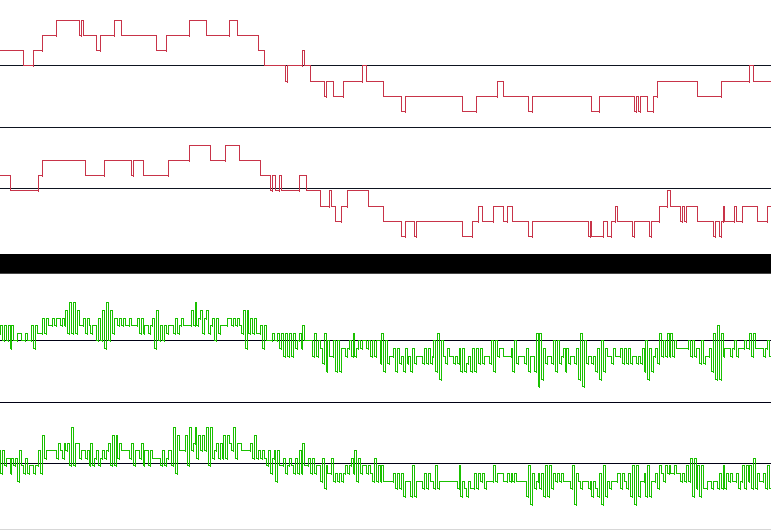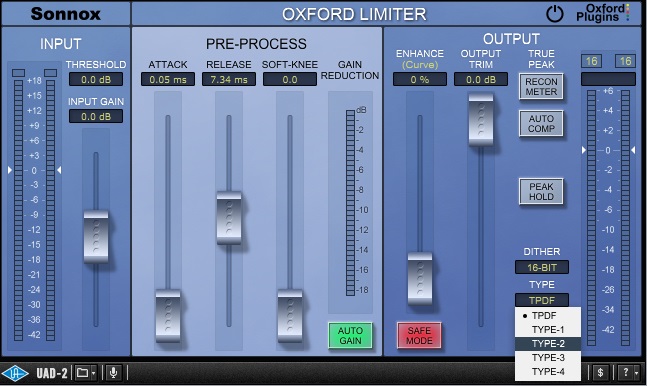Maybe yes, maybe no…let’s investigate
Well…maybe, maybe not. If you’re slamming a dance track with a high average level, then the answer is almost certainly “no.” With a nuanced acoustic recording that has a super-wide dynamic range, the answer might still be no, but you may be able to perceive—even if you don’t exactly hear—a difference.
Dithering came into being due to limitations of 16-bit audio, so in a sense, this article has elements of a history lesson because the trend is to higher-resolution audio. As you’ll hear in the audio examples, with 24-bit recording and playback, dithering becomes irrelevant. But it’s not a 24-bit world yet. Most hard-disk recorders have an audio engine with at least 32-bit, floating-point resolution, but if your music ends up on a CD, you’re down to 16 bits of resolution. Although CD sales continue to decline, 50,000,000 CDs were sold in 2019 and they’re still the most common way to sell music at merch tables, so the medium still has life in it.
Before the advent of dithering, an audio file’s “extra” bits were simply discarded when they were exported to 16-bit files. If you’ve heard a buzzing sound at the very end of a fade-out or reverb tail, that’s because the least significant bits can no longer reproduce smooth audio variations. Dithering adds a controlled type of noise to the lowest-level signals, which can reduce this type of noise (Fig. 1).

WHY DITHERING IS NEEDED
The reason why you hear a buzzing at the end of fades with truncated signals is that the least significant bit, which tries to follow the audio signal, switches back and forth between 0 and 1. This buzzing is called quantization noise, because the noise occurs during the process of quantizing the audio into discrete steps. In a 24-bit recording, the lower 8 bits beyond 16 bits account for 256 different possible levels between the “on” and “off” condition; but once the recording has been truncated, the resolution is no longer there to reproduce those changes.
Bear in mind, though, that these are very low-level signals. For that punk rock-industrial-dance mix where all the meters are in the red, you probably don’t need even 16 bits of resolution. But when you’re trying to record the ambient reverb tail of an acoustic space, you need good low-level resolution.
It may seem odd that adding noise can improve the sound, but psycho-acoustics is on our side. Any noise added by the dithering process has a constant level and frequency content, so our ears have an easy time picking out the content (signal) from the noise. But can you even hear audio that low? Let’s find out, and listen to a bunch of audio examples.
1. Load a mixed audio file into your DAW, and set the volume for a comfortable listening level.
2. Now, normalize the file to -60 dB (or, use clip gain or a clip envelope to reduce the audio amplitude without changing the listening level).
Unless your idea of a comfortable listening level is to blow your ears off, playing the file back at -60 dB will be inaudible or at least, very faint. Bear in mind that this is the kind of level (and lower) where dithering does its thing.
As a result, dithering has the most impact with music that has wide dynamics, doesn’t necessarily hit 0 very often (if at all), and is at a fairly loud playback level. For example, you won’t hear the impact of dithering on highly-compressed pop music, but you may hear it on the reverb tails of acoustic symphonic recordings playing back from 16-bit CDs.
16- AND 24-BIT NON-DITHERED AUDIO EXAMPLES
let’s listen to the difference between a reference file, a 16-bit version without dithering, and a 24-bit version without dithering. When you hear the 16-bit version, you’ll understand why dithering is needed when reducing the bit resolution down to 16 bits. To obtain these examples, I normalized a snippet of reference audio from my Simplicity album down to -80 dB, and exported as both 16-bit and 24-bit files. I then normalized both of them back up to an audible level.
Now let’s listen to the same file, but at -80 dB, with 16-bit resolution, and no dithering
If we listen to the same file at -80 dB and no dithering, but with 24-bit resolution, you can hear how 24 bits greatly improves the sound quality with low-level audio signals.
Clearly, we have some problems with 16-bit, low-level signals. Dithering improves the sound tremendously, so let’s explore why, and then listen to audio examples of different types of dithering.
HOW DITHERING WORKS
Let’s assume our original file was recorded with 24-bit resolution, but we need to truncate it to 16 bits to produce a CD, or meet the requirements of a particular digital distribution service. The dithering process adds random noise to the lowest eight bits of the 24-bit signal. This noise is different for the two channels in order not to degrade stereo separation. Adding noise to the lower eight bits increases their amplitude, and pushes some of the information contained in those bits into the higher bits. Therefore, the lowest part of the dynamic range no longer correlates directly to the original signal, but to a combination of the noise source and information present in the lowest eight bits. This reduces the quantization noise, providing in its place a smoother type of hiss modulated by the lower-level information. The most obvious audible benefit is that fades become smoother and more realistic, but there’s also more sonic detail.
Note that there are different types of dithering noise, which exhibit varying degrees of audibility. The dither may be wideband, thus trading off the lowest possible distortion for slightly higher perceived noise. A narrower band of noise will sound quieter, but lets some extremely low-level distortion remain. The next audio example uses a basic form of dithering.
To make dithering even less problematic, noise shaping distributes noise across the spectrum so that the bulk of it lies where the ear is least sensitive (i.e., the higher frequencies). Some noise shaping curves are extremely complex—they’re not just a straight line, but also dip down in regions of maximum sensitivity (typically the midrange). Mastering programs like iZotope Ozone, some plug-ins designed for mastering (like the T-RackS One at the top of the article), and even some DAWs offer multiple “flavors” of dithering.

EVALUATING DIFFERENT DITHERING ALGORITHMS, WITH AUDIO EXAMPLES
Different manufacturers use different noise-shaping algorithms; judging these is a little like wine-tasting. Sometimes you’ll have a choice of dithering and noise-shaping algorithms so you can choose the combination that works best for specific types of program material. Not all these algorithms are created equal, nor do they sound equal. However, I recommend not obsessing over this—I think your time is better spent obsessing over chord progressions and lyrics! Let’s listen to various examples of “designer” dithering.
If you want to determine how dithering sounds with your music:
1. Normalize a copy of your final, 24-bit (or higher) mix down to a low level, like -70 to -80 dB.
2. Export it to multiple 16 bit files, using various dithering options.
3. Load the dithered, 16-bit test files into your DAW.
4. Normalize them up to maximum so you can hear the results of the dithering.
5. As you master your mix, apply the one you like best.
THE RULES FOR APPLYING DITHERING
The First Law of dithering is to dither only when converting a high bit-rate source format to one with lower resolution. Typically, this is from your high-resolution master or mix to the 16-bit, mixed-for-CD format.
For example, if you are given an already dithered 16-bit file to edit on a high-resolution waveform editor, that 16-bit file already contains dithered data, and the higher-resolution editor should preserve it. When it’s time to mix the edited version back down to 16 bits, simply transfer over the existing file without dithering.
Another possible problem occurs if you give a mastering or duplication facility two dithered 16-bit files that are meant to be crossfaded. Crossfading the dithered sections could lead to artifacts; you’re better off crossfading the two, then dithering the combination.
Also, check any programs you use to see if dithering is enabled by default, or enabled accidentally and saved as a preference. In general, you want to leave dithering off, and enable it only as needed. Also make sure you don’t have two plug-ins that both default to dithering in series.
Dithering a master file is appropriate for converting something like a 24-bit file to MP3, but it’s important to use basic dithering options like triangular or rectangular. Noise-shaped dithering can interfere with the data compression process.
And there you have it—what you need to know about dithering. If your music includes wide, natural dynamics, proper dithering can indeed give a sweeter, smoother sound free of digital quantization distortion when you downsize to 16 bits.
